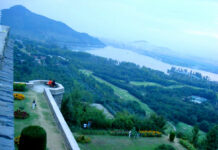Kashmir has a decadal developmental deficit. Post-liberalization that triggered massive developmental plans and most of Indian states were busy increasing their capacities to digest the capital, the scene in Kashmir was dominated by death and destruction. Now, when improved situations are helping better investments, the institutional capacities are still limited and myopic leading to lop-sided development.

Every year, the state government acquires thousands of hectares of land in the state as various road and other construction schemes have triggered immense appetite for land. After the railways, the major project that requires a lot of land is the alternative highway that would link Srinagar with Jammu, bypassing almost every major town. The work is in the progress. Barring bridges in part of the stretch in south Kashmir, the main earth cutting is over. The scenes at certain spots look like as if a runway is being created. There are two major issues that the policy makers should keep in mind. First, it is the economic use of land. Kashmir is one of the few places where land is the ultimate resource of identity and it is not plenty. The land holding in Kashmir per family is one of the lowest in India. Acquiring plenty of land passing through paddy fields, apple orchards and saffron farms is the ultimate disservice that any planner could do to Kashmir. At a place where land is under such stress created by the urbanization, the planners should have opted for other options. There is a possibility of costs soaring if the other options like overhead roads are availed but this would not lead to dispossession of the ultimate resource. This trend has created a section of population that is virtually landless.
Second, the intervention of politicians and the corruption at official level in the systems of compensation need to looked into carefully. In south Kashmir, for instance, two patches of the same swath of land have been acquired at two different rates. If the planners are making clear discrimination between the people who have access to the mighty and powerful and those who are fall in the “mango men” category, the crisis will lead to a massive impact on the socio-economic life of the people. It needs to be fair and sympathetic and prevent society from having new underdogs. Third, the financial institutions and the welfare organizations including NGOs need to play some kind of a role in managing all this. People are being compensated and it seems easy money, initially. Given the massive consumerism, most of it goes to the luxurious which the people may not require at all. They need to be advised and counselled on how this money should be spent. The financial institutions must evolve products that will help these families from becoming new paupers in the Kashmir development game that every government is so keen to accomplish.









